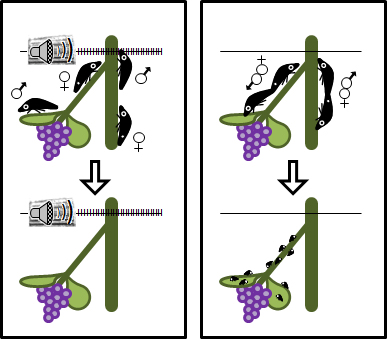BACKGROUND
Glassy-winged sharpshooter (GWSS), Homalodisca vitripennis (Germar) (Hemiptera: Cicadellidae) is an important vector of the bacterium Xylella fastidiosa, the causal agent of Pierce’s disease of grapevine. Area-wide insecticide applications have suppressed GWSS populations for ca. 25 years, but reduced levels of insecticide susceptibility have been reported. Therefore, alternative methods of control are needed. Objectives of this study were to evaluate efficacy of playback of vibrational mating communication signals for disrupting mating of GWSS in a natural vineyard setting and evaluate spectral properties of signal transmission through vineyard trellis.
RESULTS
Playback reduced mating of GWSS on grapevines. A total of 28 (out of 134) male-female pairs mated in the control treatment (silence) and only one (out of 134) pair mated when treated with the vibrational signal playback. Playback of vibrational signals through vineyard trellis was affected by distance from signal source, with frequency composition and intensity being the highest at the signal source and lowest on vines positioned away from the source. Frequency composition in canes housing test insects decreased exponentially as distance from the source increased, whereas the relative amplitude of analyzed frequencies decreased linearly.
CONCLUSION
Although further studies are needed prior to method implementation, data from this study continue to support integration of vibrational mating disruption with current methods to suppress GWSS populations.

